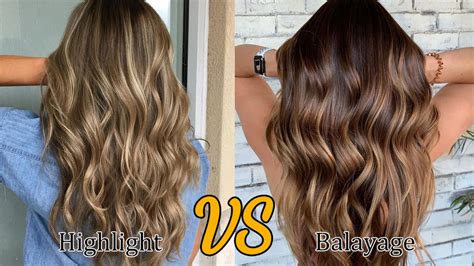Introduction

In the ever-evolving realm of hair coloring, two techniques have emerged as frontrunners: highlights and balayage. Both offer unique advantages and cater to different hair needs. This comprehensive guide delves into the distinctions between these techniques, empowering you to make an informed decision for your next hair transformation.
What is Highlight?
Highlights involve lightening specific strands of hair, creating a contrast between lighter and darker sections. This technique is particularly effective for adding depth and dimension to dark hair.
Types of Highlights:
- Foil Highlights: Strands are isolated using aluminum foil, allowing for precise control over the placement and thickness of the lighter sections.
- Cap Highlights: A rubber cap with holes is used to pull strands through, providing a more natural and diffused result.
- Comb Highlights: A comb with fine teeth is used to separate and color strands, creating an even distribution of highlights.
What is Balayage?
Balayage is a freehand painting technique where color is applied directly to the hair using a brush. This creates a more gradual and natural-looking gradation of color, with no visible lines of demarcation.
Types of Balayage:
- Classic Balayage: A soft, subtle gradation of color that blends seamlessly with the base hair color.
- Reverse Balayage: Darker tones are added to lighter hair, creating a shadowed effect.
- Ombré Balayage: A combination of balayage and ombré, where the color gradually transitions from dark to light or vice versa.
Highlight vs Balayage: The Key Differences
| Feature | Highlight | Balayage |
|---|---|---|
| Technique | Specific strands are lightened | Color is painted freehand |
| Appearance | Defined, contrasting sections | Gradual, natural-looking gradation |
| Placement | Precise | Varies depending on the brush strokes |
| Maintenance | Requires regular touch-ups | Lower maintenance than highlights |
| Cost | Generally more expensive | Typically less expensive |
Which Technique is Right for You?
Highlight:
- Ideal for adding depth and dimension to dark hair
- Creates a bolder, more defined look
- Requires regular touch-ups to maintain the contrast
Balayage:
- Suitable for all hair colors, creating a natural and sun-kissed effect
- Requires less maintenance than highlights
- Provides a more subtle and diffused result
Pros and Cons
Highlight:
Pros:
- Adds definition and dimension
- Can create a dramatic or subtle effect, depending on the placement
- Long-lasting, with regular touch-ups
Cons:
- Can be more expensive than balayage
- Requires more maintenance to keep the contrast
- Can damage hair if not done properly
Balayage:
Pros:
- Creates a natural-looking, sun-kissed effect
- Lower maintenance than highlights
- Less damaging to hair
Cons:
- May not be suitable for creating sharp contrasts
- Can be time-consuming to apply
- May need to be refreshed every 6-8 weeks
Step-by-Step Comparison
Traditional Highlights:
- Consult with a colorist to determine the desired shade and placement of highlights.
- Isolate strands of hair using aluminum foil or a rubber cap.
- Apply the bleaching agent to the isolated strands.
- Monitor the progress and remove the bleach once the desired level of lightening is achieved.
- Tone or color the highlights to blend with the base hair color.
Balayage:
- Consult with a colorist to determine the desired shade and gradation of color.
- Divide the hair into sections and apply the bleach mixture freehand using a brush.
- Feather the color out using strokes that resemble painting.
- Monitor the progress and remove the bleach once the desired level of lightening is achieved.
- Tone or color the balayage to blend with the base hair color.
Why Highlights and Balayage Matter
Both highlight and balayage can enhance the beauty and versatility of your hair. They can:
- Frame the face and create a more youthful appearance
- Add texture and depth to thin or flat hair
- Conceal gray hairs
- Create a personalized and unique look
Health Considerations
All hair coloring techniques involve some degree of chemical processing, which can potentially damage the hair. It is crucial to:
- Choose a reputable salon and experienced colorist
- Follow the aftercare instructions provided by your stylist
- Use protective hair products and minimize heat styling to maintain healthy hair
Innovative Applications of Highlight and Balayage
In addition to traditional uses, highlight and balayage techniques can be creatively applied to achieve new and exciting looks:
- Peek-a-Boo Highlights: Hidden highlights that are only visible when the hair is tied up or styled.
- Foilayage: A combination of foil highlights and balayage that creates a soft, lived-in effect.
- Shadow Root Balayage: A balayage technique that focuses on darkening the roots, creating a natural and low-maintenance look.
Conclusion
Whether you prefer the bolder contrast of highlights or the natural-looking gradation of balayage, both techniques offer unique advantages and can transform your hair into a work of art. By understanding the key differences, benefits, and maintenance requirements of each technique, you can make an informed decision and achieve the hair color of your dreams.
